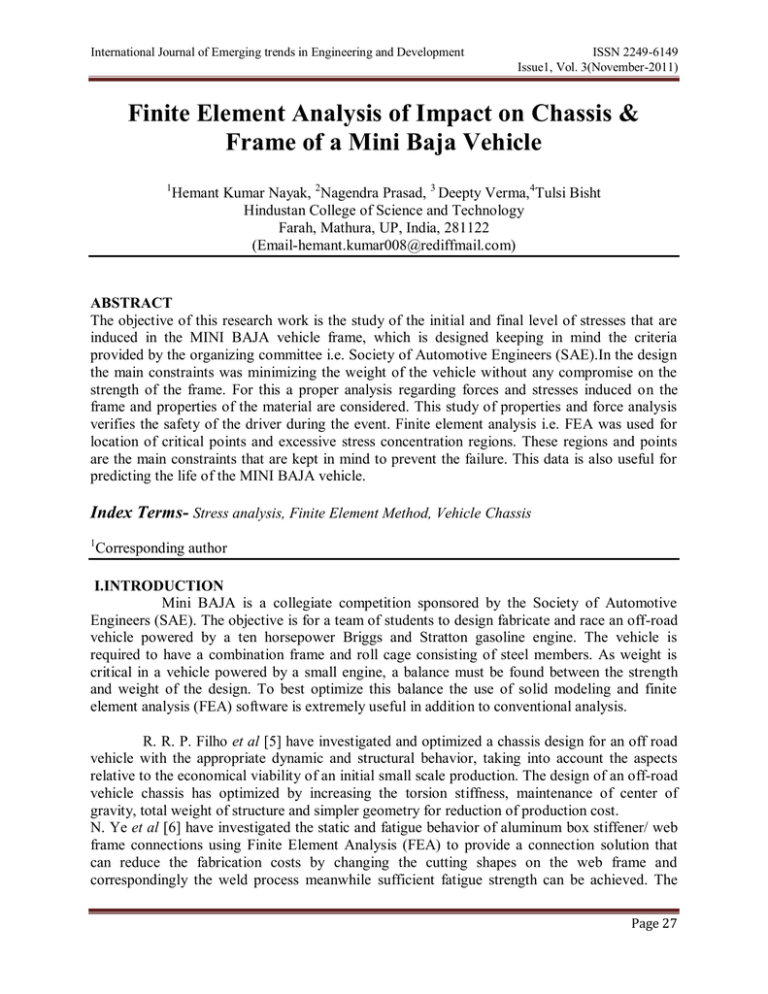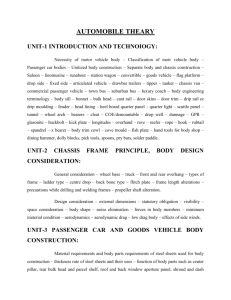International Journal of Emerging trends in Engineering and
advertisement

International Journal of Emerging trends in Engineering and Development ISSN 2249-6149 Issue1, Vol. 3(November-2011) Finite Element Analysis of Impact on Chassis & Frame of a Mini Baja Vehicle 1 Hemant Kumar Nayak, 2Nagendra Prasad, 3 Deepty Verma,4Tulsi Bisht Hindustan College of Science and Technology Farah, Mathura, UP, India, 281122 (Email-hemant.kumar008@rediffmail.com) ABSTRACT The objective of this research work is the study of the initial and final level of stresses that are induced in the MINI BAJA vehicle frame, which is designed keeping in mind the criteria provided by the organizing committee i.e. Society of Automotive Engineers (SAE).In the design the main constraints was minimizing the weight of the vehicle without any compromise on the strength of the frame. For this a proper analysis regarding forces and stresses induced on the frame and properties of the material are considered. This study of properties and force analysis verifies the safety of the driver during the event. Finite element analysis i.e. FEA was used for location of critical points and excessive stress concentration regions. These regions and points are the main constraints that are kept in mind to prevent the failure. This data is also useful for predicting the life of the MINI BAJA vehicle. Index Terms- Stress analysis, Finite Element Method, Vehicle Chassis 1 Corresponding author I.INTRODUCTION Mini BAJA is a collegiate competition sponsored by the Society of Automotive Engineers (SAE). The objective is for a team of students to design fabricate and race an off-road vehicle powered by a ten horsepower Briggs and Stratton gasoline engine. The vehicle is required to have a combination frame and roll cage consisting of steel members. As weight is critical in a vehicle powered by a small engine, a balance must be found between the strength and weight of the design. To best optimize this balance the use of solid modeling and finite element analysis (FEA) software is extremely useful in addition to conventional analysis. R. R. P. Filho et al [5] have investigated and optimized a chassis design for an off road vehicle with the appropriate dynamic and structural behavior, taking into account the aspects relative to the economical viability of an initial small scale production. The design of an off-road vehicle chassis has optimized by increasing the torsion stiffness, maintenance of center of gravity, total weight of structure and simpler geometry for reduction of production cost. N. Ye et al [6] have investigated the static and fatigue behavior of aluminum box stiffener/ web frame connections using Finite Element Analysis (FEA) to provide a connection solution that can reduce the fabrication costs by changing the cutting shapes on the web frame and correspondingly the weld process meanwhile sufficient fatigue strength can be achieved. The Page 27 International Journal of Emerging trends in Engineering and Development ISSN 2249-6149 Issue1, Vol. 3(November-2011) following paper outlines the design and analysis of the Mini BAJA vehicle’s frame design. It will cover the design constraints required by SAE, material selection, initial design, and structural analysis and design modifications. II.FINITE ANALYSIS OF CHASIS & FRAME II.1 Design constraints The design of the Mini BAJA frame is defined by the design safety rules set out by the SAE. These rules are updated yearly to address new safety concerns. These rules define the frame design in two ways. First, the rules set specific requirements on the building material’s material type and geometry. They also define the specific requirements of the frame geometry. The requirements were referenced when making decisions regarding the material selection, design geometry and any additional modifications to the design. A thorough review of the design and rules were made at the end of the design stage before fabrication. This review included not only the letter of the guideline but also a discussion of the intent. In any cases in which the clarity or meaning of a rule was in doubt, the SAE rules committee was contacted to ensure compliance. It is important that the reader understand that these constraints were in place during the design of the vehicle frame, as well as the interaction between the frame design and other factors, such as drive train, suspension, and driver safety and restraint. II.2 Model of chassis The model of the chassis & frame is drawn with the help of solid works, keeping in mind the constraints and limits that were suggested by the governing body keeping in mind the driver’s safety as priority. The model is depicted in figure 2.1. The model has length of 1.65m and width of 1.15 m. The material of chassis is AISI 4130 Chromium- Molybdenum Alloy Steel which is class of alloy steel with 360.6 MPa of yield strength and 560.5 MPa of tensile strength. The other properties of chassis material are tabulated in Table 2.1. Figure 2.1 Models of Chassis Page 28 International Journal of Emerging trends in Engineering and Development ISSN 2249-6149 Issue1, Vol. 3(November-2011) Table 2.1 Properties Of Chassis Material Conditions Properties T (°C) Density (×1000 kg/m3) 7.7-8.03 25 Poisson's Ratio 0.27-0.30 25 Elastic Modulus (GPa) 190-210 25 Tensile Strength (Mpa) 560.5 Yield Strength (Mpa) 360.6 Treatment 25 annealed at 865°C more Elongation (%) 28.2 Reduction in Area (%) 55.6 Hardness (HB) 156 25 annealed at 865°C more Impact Strength (J) (Izod) 61.7 25 annealed at 865°C more II.3 Loading The chassis model is analyzed for the effect of impact forces from the front, rear & side portion of the vehicle. For this model, the maximum force is 5500 N. The load is assumed as a uniform pressure obtained from the maximum loaded weight divided by the total contact area from the front and the rear side. Detail loading of model is shown in below. In both the cases, when force is applied the degree of freedom have to be fixed in opposite direction. III.RESULTS AND DISCUSSIONS III.1. Front impact force analysis Page 29 International Journal of Emerging trends in Engineering and Development ISSN 2249-6149 Issue1, Vol. 3(November-2011) The figure shows the maximum axial displacement. During the front impact analysis, the value of maximum displacement will be 2.3 mm. The value of maximum lateral displacement will be 1.7 mm. The figure 1 shows the lateral displacement of the bars of the chassis. The figure 2 shows the maximum Von Misses stress and figure 3 shows the strain. The stress magnitude of critical point is 50 MPa. The maximum stress occurs at the side of the vehicle near the driver’s cabin. Figure-1 Maximum Axial Displacement/Front Side Figure-2 Von Misses Stresses/Front Side Page 30 International Journal of Emerging trends in Engineering and Development ISSN 2249-6149 Issue1, Vol. 3(November-2011) Figure-3 Strain At Front Side III.2 Rear impact force analysis The figure 2.1 shows the maximum axial displacement. During the rear impact analysis, the value of maximum displacement will be 5.5 mm. The value of maximum lateral displacement will be 2.7 mm. The figure 2.2shows the maximum Von Misses stress. The stress magnitude of critical point is 100 MPa. The maximum stress occurs at the rear side of the vehicle where engine will be placed and the strain is shown in the figure 2.3 Figure- 2.1 Maximum Axial Displacement Page 31 International Journal of Emerging trends in Engineering and Development ISSN 2249-6149 Issue1, Vol. 3(November-2011) Figure-2.2 Von Misses Stresses /Rear Side Figure 2.3 Strains At Rear Side Page 32 International Journal of Emerging trends in Engineering and Development ISSN 2249-6149 Issue1, Vol. 3(November-2011) CONCLUSIONS Numerical simulation result shows that the critical point of stress occurred at side of the chassis during front loading and at rear side near the place where engine is placed. The magnitude of highest stress is critical because the value of SF is below than the recommended value. Since fatigue failure started from the highest stress point, it can be concluded that this critical point is an initial to probable failure. Thus, it is important to take note to reduce stress magnitude at this point. REFERENCES [1] M. Fermer, G. McInally and G. Sandin, Fatigue Life Analysis of Volvo S80 Bi-Fuel using MSC/Fatigue, Worldwide MSC Automotive Conference, Germany, September, 1999. [2] F. A. Conle and C.-C. Chu, Fatigue Analysis and the Local Stress-strain Approach in Complex Vehicular Structures, International journal of fatigue, 1997. [3] W. G. Ferreira, F. Martins, S. Kameoka, A. S. Salloum, and J. T. Kaeya, Structural Optimization of Automotive Components Applied to Durability Problems, SAE Technical Papers, 2003. [4] M. Fermér and H. Svensson, Industrial Experiences of FE-based Fatigue Life Predictions of Welded Automotive Structures, Fatigue & Fracture of Engineering Materials and Structures 24 (7), 2001, 489–500. [5] R. R. P. Filho, J. C. C. Rezende, M.de F. Leal, J. A. F. Borges, Automotive Frame Optimization, 12th International Mobility Technology Congress and Exhibition, Sao Paulo, Brasil, November 18 – 20, 2003. [6] N. Ye and T. Moan, Static and Fatigue Analysis of Three Types of Aluminium BoxStiffener/Web Frame Connections, International Journal of Fatigue 29 (2007) 1426–1433 Page 33


